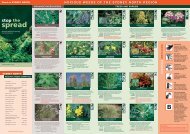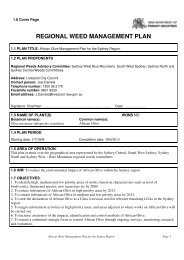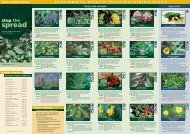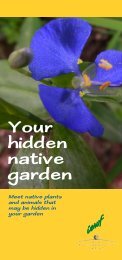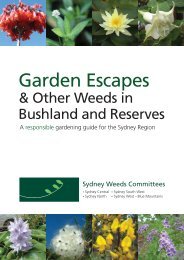Bulbous & Succulent Weeds - Sydney Weeds Committees
Bulbous & Succulent Weeds - Sydney Weeds Committees
Bulbous & Succulent Weeds - Sydney Weeds Committees
Create successful ePaper yourself
Turn your PDF publications into a flip-book with our unique Google optimized e-Paper software.
<strong>Bulbous</strong> & <strong>Succulent</strong> <strong>Weeds</strong><br />
34<br />
<strong>Bulbous</strong> & <strong>Succulent</strong> <strong>Weeds</strong><br />
These plants are extremely hardy due to their above ground and below ground<br />
storage structures, which are modified leaves, stems and roots.<br />
This group of plants includes all of the Asparagus species. These plants are<br />
prolific, hardy (drought-resistant), shade tolerant and highly invasive. They<br />
have extensive underground rhizomes that form thick mats capable of<br />
reducing water penetration into soil; vigorous vegetative structures that are<br />
capable of smothering native vegetation and produce copious amounts of<br />
berries (red or black) that are readily consumed and spread by animals and<br />
birds. They are also spread by green waste dumping as rhizomes are capable<br />
of surviving for long periods of time out of the soil.<br />
The main weed species are featured on their own pages but below is a list of:-<br />
Other Problematic <strong>Bulbous</strong> & <strong>Succulent</strong> <strong>Weeds</strong><br />
Common Name<br />
Botanical Name<br />
Aloes<br />
Aloe spp.<br />
Asparagus Fern<br />
Asparagus scandens (WoNS)<br />
Bridal Veil<br />
Asparagus declinatus (WoNS)<br />
Cactus/Prickly Pears<br />
Harrisia, Opuntia & Cylindropuntia spp.<br />
Century Plant<br />
Agave americana, Agave spp.<br />
Coastal Gladiolus<br />
Gladiolus gueinzii<br />
Freesia<br />
Freesia x hybrida/Freesia refracta<br />
Gladiolus<br />
Gladiolus spp.<br />
Mother in Law’s Tongue Sanseviera spp.<br />
Naked Lady<br />
Amaryllis belladonna<br />
Philippine Lily<br />
Lilium philippinense<br />
Soursob/Shamrock/Wood Sorrel Oxalis spp. (Noxious)<br />
Various <strong>Succulent</strong>s<br />
Sedums, Kalanchoe, and many other Genera<br />
Bridal Creeper fact: First recorded in Australia in 1857 in a nursery<br />
catalogue. By the 1870’s Bridal Creeper was a common garden plant;<br />
its flowers were used in floral arrangements, particularly in wedding<br />
bouquets. Within 50 years of introduction, bridal creeper had become<br />
naturalised in many areas across most of southern Australia and has<br />
earned its Status as a Weed of National Significance.
Agapanthus<br />
Agapanthus spp.<br />
Family:<br />
Origin:<br />
Habit:<br />
Leaves:<br />
Flowers:<br />
Fruit:<br />
Roots:<br />
Dispersal:<br />
Control:<br />
Alliaceae<br />
Africa<br />
One of the most widely planted ornamental<br />
landscape plants, Agapanthus have invaded<br />
natural areas including the Blue Mountains<br />
world heritage area.<br />
An erect fleshy, clumping, perennial lily with long strappy leaves.<br />
Long (up to 700mm), strap-like, glossy bright green, fleshy.<br />
Small (30mm) trumpet shaped blue or white flowers that form<br />
large spherical clusters (umbels) at the end of long (1200mm)<br />
smooth tubular stalks. Very showy floral display in Summer.<br />
Three-sided leathery green capsules form in clusters at the<br />
end of stalks, drying brown and papery when mature.<br />
Contain numerous winged, small black seeds.<br />
Shallow, fleshy, densely matted and quite robust.<br />
Seed and tubers spread by water, wind, humans,<br />
contaminated soil (earthmoving equipment, car tyres etc)<br />
and garden refuse dumping.<br />
Hand pull/dig, bagging all plant parts and removing from site.<br />
Foliar spray, Cut and Paint.<br />
This is a popular garden plant that needs<br />
active management in all gardens. This<br />
may be as simple as actively removing<br />
spent flower stalks prior to seed set,<br />
or as comprehensive as complete removal<br />
from gardens.<br />
<strong>Bulbous</strong> & <strong>Succulent</strong> <strong>Weeds</strong><br />
35
Arum Lily<br />
Used extensively in floral arrangements all<br />
Zantedeschia species are highly toxic if eaten raw.<br />
They are known to have caused the deaths of<br />
cattle and children. All parts of the plant are toxic,<br />
Araceae and produce irritation and swelling of the mouth<br />
and throat, acute vomiting and diarrhoea.<br />
South Africa<br />
Erect, tuberous, evergreen perennial herb to 1.5m high.<br />
Arrowhead shaped, dark green leaves to 45cm long and 20cm<br />
wide borne at the ends of stout, smooth, succulent green stems<br />
to 75cm long and winged at the base.<br />
Pale Yellow spike to 9cm long surrounded by a pure white funnel<br />
shaped spathe to 25cm coming to a point. Winter-Summer.<br />
Berry, green or yellow maturing to orange 5-10mm long<br />
containing about 4 yellow-brown seeds.<br />
Fleshy tuberous rhizome.<br />
Rhizomes, cormlets and Seed is spread by water, humans,<br />
contaminated soil (earthmoving equipment, car tyres etc) and<br />
garden refuse dumping.<br />
Hand pull/dig, bagging all plant parts and removing from site.<br />
Foliar spray, Cut and Paint.<br />
Zantedeschia aethiopica<br />
Family:<br />
Origin:<br />
Habit:<br />
Leaves:<br />
Flowers:<br />
Fruit:<br />
Roots:<br />
Dispersal:<br />
Control:<br />
<strong>Bulbous</strong> & <strong>Succulent</strong> <strong>Weeds</strong><br />
36
Asparagus - Bridal Creeper<br />
Asparagus asparagoides<br />
Family:<br />
Origin:<br />
Habit:<br />
Leaves:<br />
Flowers:<br />
Fruit:<br />
Roots:<br />
Dispersal:<br />
Control:<br />
Asparagaceae<br />
South Africa<br />
Bridal creeper is widespread in Western<br />
Australia, South Australia and Victoria. It is also<br />
spreading in New South Wales and Tasmania. It<br />
has the potential to spread further and increase<br />
its density in all southern states.<br />
Wiry twinning climber to 3m in length and branch extensively.<br />
Stems emerge annually in autumn from a mat, 0-10cm deep.<br />
Bright green with alternate, flattened, shiny, stems (leaf-like)<br />
that are pointed ovate shape and have parallel venation,<br />
leaves 4-30mm wide and 10-70mm long which occur along<br />
the length of wiry green stems.<br />
White, 6-petalled flowers, 5-8mm in diameter, appear in<br />
early Spring.<br />
Pea-sized green berries turning pink then red/burgundy in late<br />
spring-early summer. Berries contain 1-9 seeds that are black<br />
when mature.<br />
Branching rhizomes that bear numerous fleshy tubers.<br />
Seed spread by water, animals, birds, humans, contaminated<br />
soil (earthmoving equipment, car tyres etc) and garden<br />
refuse dumping.<br />
Difficult to control – crowning, ensure that the crown is<br />
removed off site. Remove and bag berries. Follow-up –<br />
hand -pull all emerging seedlings. Foliar spray.<br />
Similar Native Species: Wombat Berry (Eustrephus latifolius)<br />
<strong>Bulbous</strong> & <strong>Succulent</strong> <strong>Weeds</strong><br />
37
Asparagus - Climbing<br />
Protasparagus plumosus<br />
Protasparagus setaceous<br />
Family:<br />
Origin:<br />
Habit:<br />
Leaves:<br />
Flowers:<br />
Fruit:<br />
Roots:<br />
Dispersal:<br />
Control:<br />
Asparagaceae<br />
South Africa<br />
A very popular indoor plant because of its ability<br />
to withstand low light and neglect, this plant<br />
is naturalised in sheltered sites and rainforests<br />
infesting many hectares on the NSW coast.<br />
Tough, perennial, wiry, twining climbing vine with occasional<br />
spines and fine, feathery fern like foliage.<br />
Fine, feathery, leaf-like cladodes arranged in horizontal sprays.<br />
Flowers are small, greenish-white and arranged at the tips of<br />
branches in Summer.<br />
Bluish-green berries to 0.5cm across that turn black when ripe<br />
in Autumn.<br />
A tough, woody crown is forged at base of stems, with a<br />
comprehensive fleshy root mass radiating out from the crown.<br />
Seed spread by water, animals, birds, humans, contaminated<br />
soil (earthmoving equipment, car tyres etc) and garden<br />
refuse dumping.<br />
Difficult to control – crowning, ensure that the crown is<br />
removed off site. Remove and bag berries. Follow-up –<br />
hand-pull all emerging seedlings. Foliar spray.<br />
<strong>Bulbous</strong> & <strong>Succulent</strong> <strong>Weeds</strong><br />
38
Asparagus - Ground<br />
Protasparagus aethiopicus<br />
Protasparagus densiflorus<br />
Family:<br />
Origin:<br />
Habit:<br />
Leaves:<br />
Flowers:<br />
Fruit:<br />
Roots:<br />
Dispersal:<br />
Control:<br />
Asparagaceae<br />
South Africa<br />
A very popular indoor/basket plant because of<br />
its ability to withstand low light and neglect,<br />
this plant is naturalised in sand dunes and<br />
rainforests infesting hundreds of hectares on<br />
the NSW coast.<br />
Herbaceous perennial, highly invasive, sprawling ground<br />
cover with wiry, much branched stems up to 2m. A tough,<br />
woody crown is formed at base of stems. Dense mats of<br />
branches will smother low native vegetation and suppress<br />
natural regeneration.<br />
Up to 2.5cm, bright green, ferny, leaf-like cladodes with a<br />
distinct midrib and abrupt point.<br />
Small, white to pale pink, bell shaped flowers in clusters<br />
produced during Summer.<br />
Pale green berries that ripen to red in late winter early spring.<br />
Comprehensive and thick mat of tuberous roots spreading<br />
from crown.<br />
Seed spread by water, animals, birds, humans, contaminated<br />
soil (earthmoving equipment, car tyres etc) and garden<br />
refuse dumping.<br />
Difficult to control – crowning, ensure that the crown is<br />
removed off site. Remove and bag berries. Follow-up –<br />
hand-pull all emerging seedlings. Foliar spray.<br />
<strong>Bulbous</strong> & <strong>Succulent</strong> <strong>Weeds</strong><br />
Photo: Steve Howard<br />
39
Asparagus - Culinary<br />
Asparagus officinalis Unlike most other weeds of this family the culinary<br />
asparagus is native to Europe not South Africa.<br />
It does however share many of its counter parts<br />
Family: Asparagaceae weedy traits such as developing succulent berries<br />
Origin: Europe<br />
and growing dense underground rhizomes and<br />
root mats.<br />
Habit: Grown for culinary purposes. Hardy perennial with robust spears<br />
and prolific fern like vegetative structures 1.5 to 2.0m tall.<br />
Leaves: Fine, feathery, leaf-like cladodes arranged in cylindrical sprays.<br />
Flowers:<br />
Fruit:<br />
Roots:<br />
Dispersal:<br />
Control:<br />
Flowers are small, bell shaped, greenish-white and arranged at<br />
the base of branches in Summer.<br />
Bluish-green berries to 0.5cm across that turn red when<br />
ripe in Autumn.<br />
A tough, woody crown is forged at base of stems, with a<br />
comprehensive fleshy root mass radiating out from the crown.<br />
Seed spread by water, animals, birds, humans, contaminated<br />
soil (earthmoving equipment, car tyres etc) and garden<br />
refuse dumping.<br />
Difficult to control – crowning, ensure that the crown is<br />
removed off site. Remove and bag berries. Follow-up –<br />
hand-pull all emerging seedlings. Foliar spray.<br />
<strong>Bulbous</strong> & <strong>Succulent</strong> <strong>Weeds</strong><br />
This is a popular vegetable<br />
garden plant that needs active<br />
management. This may be as simple<br />
as removing vegetative stalks prior<br />
to seed set, or as comprehensive as<br />
complete removal from gardens.<br />
40
Canna Lily/Indian Shot<br />
Canna indica<br />
Canna x generalis<br />
Family:<br />
Origin:<br />
Habit:<br />
Leaves:<br />
Flowers:<br />
Fruit:<br />
Roots:<br />
Dispersal:<br />
Control:<br />
Cannaceae<br />
Tropical<br />
and South<br />
America<br />
A very widely planted species that prefers wet<br />
boggy sites. Commonly used in septic tank<br />
absorption trenches. Garden refuse dumping and<br />
deliberate planting in reserves and wetland areas<br />
is the main problem.<br />
Erect, herbaceous perennial to 2m high with No true stems.<br />
Stems are a collection of tightly furled leaf bases.<br />
Dark green to multi coloured and striped, large (60 x 25cm),<br />
arranged alternately on stems.<br />
Tubular flowers (yellows oranges, reds and pinks) formed in<br />
asymmetrical clusters. Spring-Autumn.<br />
Black, globular seeds (5-7mm long) borne in capsule, and<br />
spread by birds.<br />
Extensive, fleshy rhizome formed underground.<br />
Seed and rhizomes spread by water, humans, contaminated<br />
soil (earthmoving equipment, car tyres etc) and garden<br />
refuse dumping.<br />
Hand pull/dig, bagging all plant parts and removing from site.<br />
Foliar spray, Cut and Paint.<br />
<strong>Bulbous</strong> & <strong>Succulent</strong> <strong>Weeds</strong><br />
41
Elephants Ears/Taro<br />
Colocasia esculenta<br />
Family:<br />
Origin:<br />
Habit:<br />
Leaves:<br />
Flowers:<br />
Fruit:<br />
Roots:<br />
Dispersal:<br />
Control:<br />
Plants such as these with fleshy tuberous rhizomes,<br />
when established in moist areas become extremely<br />
Araceae<br />
heavy and difficult to remove. Do not let them<br />
establish outside of gardens.<br />
S.E. Asia,<br />
Hawaii, and the<br />
Pacific Islands<br />
Erect, rhizomatous tuberous, evergreen perennial herb to<br />
1.5m high.<br />
Heart shaped, dark green leaves to 60cm long prominently<br />
veined. Stem & leaf colour varies depending on variety of plant.<br />
Pale Yellow spike enclosed by a greenish yellow hood like spathe.<br />
Flowers Winter-Summer.<br />
Small berry, green or yellow maturing to orange 5-10mm long<br />
containing about 4 yellow-brown seeds.<br />
Fleshy tuberous rhizome.<br />
Roots, tubers and Seed is spread by water, humans,<br />
contaminated soil (earthmoving equipment, car tyres etc) and<br />
garden refuse dumping.<br />
Hand pull/dig, bagging all plant parts and removing from site.<br />
Foliar spray, Cut and Paint.<br />
<strong>Bulbous</strong> & <strong>Succulent</strong> <strong>Weeds</strong><br />
42
Fishbone Fern<br />
Nephrolepis cordifolia<br />
Family:<br />
Origin:<br />
Habit:<br />
Leaves:<br />
Flowers:<br />
Fruit:<br />
Roots:<br />
Dispersal:<br />
Control:<br />
Davalliaceae<br />
Once a popular basket and rockery plant<br />
because of its ability to withstand low light and<br />
neglect, this plant is naturalised throughout a<br />
large proportion of the NSW coast.<br />
North Eastern Australia<br />
Terrestrial fern that forms dense clumps of upright, arching fronds<br />
that resemble fish bones with erect rhizome and slender stolons.<br />
Compound fronds with opposite or alternate leaflets, often<br />
over lapping at base, to 1m. Leaflets to 6cm long.<br />
Nil.<br />
Spores carried in round, brown clusters (sori) that form in two<br />
rows on underside of frond.<br />
Erect, branching rhizomes above or below ground level, with<br />
wiry stolons bearing rounded, hairy tubers.<br />
Spores carried by water, wind and contaminated soil<br />
(tyres, earth works, people’s shoes, green waste dumping).<br />
Problematic in any damp, shady areas, where it will completely<br />
dominate ground cover layer.<br />
Hand pull/dig, bagging all plant parts and removing from site.<br />
Foliar spray.<br />
Similar local native species: Rasp<br />
Fern Doodia aspera and Sickle Fern<br />
Pellaea falcata.<br />
<strong>Bulbous</strong> & <strong>Succulent</strong> <strong>Weeds</strong><br />
43
Formosa Lily<br />
Also known as Taiwan Lily, this plant is rapidly<br />
Lilium formosanum<br />
becoming a naturalised weed in many states<br />
of Australia infesting roadsides, disturbed<br />
areas, wastelands and even bushland.<br />
Family: Liliaceae<br />
Origin: Asia (Taiwan)<br />
Habit: Deciduous perennial herb with annual flowering stalks 1-2m long.<br />
Leaves: Mid to dark green, elongated, linear, sessile leaves are arranged<br />
spirally or whirled along the stems.<br />
Flowers: Large trumpet shaped highly fragrant flowers, pure white on<br />
the inside, pink or purple/brown stripes on the outside bearing<br />
prominent yellow anthers. Summer.<br />
Fruit: Copious papery winged seeds borne in a large capsule.<br />
Roots: Underground bulb with numerous fleshy scales<br />
(resembling garlic).<br />
Dispersal: Seeds, bulbs and bulb scales spread by water, wind, humans,<br />
contaminated soil (earthmoving equipment, car tyres etc) and<br />
garden refuse dumping.<br />
Control: Difficult. Hand dig, ensuring all scales are removed. Best done<br />
before flowering. Extensive follow-up required. Remove and bag<br />
seed heads (capsules). Foliar sprays ineffective.<br />
<strong>Bulbous</strong> & <strong>Succulent</strong> <strong>Weeds</strong><br />
44
Ginger Lily<br />
Hedychium gardnerianum<br />
Large, spreading plant out-competes natives<br />
for light and moisture in moist habitats. Heavy<br />
and difficult to remove from bush.<br />
Family:<br />
Origin:<br />
Habit:<br />
Leaves:<br />
Flowers:<br />
Fruit:<br />
Roots:<br />
Dispersal:<br />
Control:<br />
Zingiberaceae<br />
Himalayas<br />
Robust perennial herb 2-3m high with creeping underground<br />
stems (rhizomes) up to 1 metre long.<br />
About 40cm long and 15cm wide. Alternately arranged and<br />
lance-shaped with long-pointed tips.<br />
Yellow with red filaments and very fragrant, in spike-like clusters,<br />
summer to autumn.<br />
Produces large amounts of seed.<br />
Large fleshy rhizomes forming dense layers up to 1 metre thick.<br />
Garden dumping of stems.<br />
Remove underground stems from contact with the soil.<br />
<strong>Bulbous</strong> & <strong>Succulent</strong> <strong>Weeds</strong><br />
Photos: Rob Gleeson<br />
45
Montbretia<br />
Crocosmia x crocosmiiflora<br />
Family:<br />
Origin:<br />
Habit:<br />
Leaves:<br />
Flowers:<br />
Fruit:<br />
Roots:<br />
Dispersal:<br />
Control:<br />
Iridaceae<br />
This pretty bulb invades bushland, roadsides<br />
streams banks and even gardens. They<br />
tolerate full sun, moist areas, frost, shady and<br />
windy conditions. Takes over and displaces<br />
indigenous grasses and ground covers.<br />
South Africa<br />
Erect deciduous perennial herb to 0.9m.<br />
Basal linear strap like flat leaves around 30-80cm long and<br />
1-2cm wide die down in autumn after producing its seeds, and<br />
reappear in Spring.<br />
Orange yellow tubular flowers are formed solitary in spike<br />
inflorescences on short wispy unbranched stems during Summer.<br />
Produces large amounts of seed.<br />
Globular corms live and produce plants for two years or more,<br />
and new corms are formed annually, Long rhizomes are also<br />
produced, each of which grows into a new plant.<br />
Roots, rhizomes, corms and seed spread by humans,<br />
contaminated soil (earthmoving equipment, car tyres etc) and<br />
garden refuse dumping.<br />
Difficult. Hand dig, ensuring all corms are removed. Extensive<br />
follow-up required. Foliar spray with penetrant when flowering.<br />
<strong>Bulbous</strong> & <strong>Succulent</strong> <strong>Weeds</strong><br />
46
Mother of Millions<br />
Bryophyllum spp.<br />
Family:<br />
Origin:<br />
Habit:<br />
Leaves:<br />
Flowers:<br />
Fruit:<br />
Roots:<br />
Dispersal:<br />
Control:<br />
Often confused with the Australian native<br />
Christmas Bells, this mat forming plant will<br />
grow under the poorest of conditions in areas<br />
such as a crack in a rock, gravel on the side of a<br />
Crassulaceae road or on cliff faces, sand dunes and pastures.<br />
Madagascar, South Africa<br />
Erect, smooth fleshy succulent stems to 2m, with green- pink<br />
grey stems.<br />
Leaves vary depending on the species, but all are succulent<br />
either cylindrical or boat shaped and have many small teeth<br />
on the leaf tip or margins that produce new plantlets<br />
(vegetative reproduction).<br />
Produced in a cluster at the tip of long stems. Flowers are drooping,<br />
bell-shaped, orange-red to scarlet, 4-lobed to 2-3cm long.<br />
Flowers mainly Winter-Spring.<br />
Dry capsule, producing hundreds of tiny black seeds. Prolific seeder.<br />
Weak fibrous roots form from all vegetative parts.<br />
Main method of reproduction is vegetative where by stem<br />
fragments re-root. Human activities such as mowing/slashing and<br />
green waste dumping are the common method of vegetative<br />
spread. Seeds are spread by water and contaminated soil.<br />
Difficult. Hand pull/dig, bagging all plant parts and removing<br />
from site. Foliar spray.<br />
<strong>Bulbous</strong> & <strong>Succulent</strong> <strong>Weeds</strong><br />
47
Parrot Alstromoeria/Peruvian Lily<br />
Alstroemeria pulchella<br />
Family:<br />
Origin:<br />
Habit:<br />
Leaves:<br />
Flowers:<br />
Fruit:<br />
Roots:<br />
Dispersal:<br />
Control:<br />
Spreading in shady sites near the coast,<br />
forming dense clumps. Expensive and difficult<br />
Alstroemeria<br />
to remove and takes up native habitat.<br />
Central and South America<br />
Erect perennial with numerous unbranched stems with<br />
spoon-shaped leaves to 1m high. Tuberous underground roots.<br />
Twisting from base<br />
Loose clusters 4-5cm across, red and green with black spots,<br />
at tops of stems. Fruit a capsule.<br />
Is a capsule.<br />
Slender rhizomes becoming crowns and tubers.<br />
Underground tubers spread underground. Fruit possibly eaten<br />
and spread by birds and or insects.<br />
Remove the entire plant including the roots. Cut individual<br />
stems near ground and paint with full strength herbicide.<br />
Follow up required.<br />
<strong>Bulbous</strong> & <strong>Succulent</strong> <strong>Weeds</strong><br />
48<br />
Photos: Rob Gleeson
49<br />
<strong>Bulbous</strong> & <strong>Succulent</strong> <strong>Weeds</strong><br />
Spanish Bayonet<br />
Yucca aloifolia<br />
Yucca spp.<br />
Family:<br />
Origin:<br />
Habit:<br />
Leaves:<br />
Flowers:<br />
Fruit:<br />
Roots:<br />
Dispersal:<br />
Control:<br />
Agavaceae<br />
Commonly cultivated, this garden escapee<br />
is found on roadsides and sand dunes. Very<br />
difficult to control due to spiny nature of plant<br />
creating impenetrable thickets.<br />
North & Central America and the West Indies<br />
Evergreen, herbacious, slow growing perennial shrub or small<br />
tree, forming large spiny rosettes of leaves. Often freely branched.<br />
Depending on species. Green-bluish grey fleshy, linear to<br />
narrow-lanceolate, 0.3-1m long, 2-5cm wide, apex acute<br />
with terminal spine 10-20mm long, margins finely toothed,<br />
surfaces glabrous.<br />
Creamy white, multi flowered panicle 1-3m long.<br />
Oblong purplish capsule, 6-8cm long, indehiscent (doesn’t open<br />
on its own accord at maturity); seeds black.<br />
Large, dense and fleshy.<br />
Seed and vegetative reproduction where stem segments and leaf<br />
rosettes take root. Spread by humans, contaminated soil (earthmoving<br />
equipment, car tyres etc) and garden refuse dumping.<br />
Hand or mechanical removal, cut and paint, drilling, foliar spray.<br />
All plant parts should be removed from site.
50<br />
<strong>Bulbous</strong> & <strong>Succulent</strong> <strong>Weeds</strong><br />
Wild Watsonia<br />
Once widely, but now rarely, planted as<br />
an ornamental. Major environmental<br />
weed of disturbed bushland and roadsides,<br />
particularly near water. Serious<br />
Iridaceae<br />
weed in W.A., S.A., Vic and N.S.W.<br />
South Africa<br />
Erect perennial herb to 2m.<br />
Basal linear/Sword-shaped leaves up to 0.6m long with distinct<br />
midrib are arranged in a fan-like formation. Above ground parts<br />
dieback to underground corm each autumn.<br />
Curved trumpet shaped salmon pink to Orange red flowers<br />
formed solitary in spike inflorescences on tall reddish<br />
unbranched stems. Spring-Summer.<br />
No seed set, but small bulbils are produced in clusters of up<br />
to 16 along the stem below the flowers.<br />
Globular corm. 1-3 new corms produced each growing season.<br />
Roots, bulbils and corms spread by water, humans,<br />
contaminated soil (earthmoving equipment, car tyres etc) and<br />
garden refuse dumping.<br />
Difficult. Hand pull/dig, ensuring all corms are removed.<br />
Extensive follow-up required. Remove and bag all bulbils.<br />
Foliar sprays available.<br />
Watsonia meriana var. bulbillifera<br />
Family:<br />
Origin:<br />
Habit:<br />
Leaves:<br />
Flowers:<br />
Fruit:<br />
Roots:<br />
Dispersal:<br />
Control:
51<br />
Grass <strong>Weeds</strong><br />
Grass <strong>Weeds</strong><br />
The Grass <strong>Weeds</strong> are commonly overlooked, however, exotic grass species are<br />
invading roadsides, reserves and bushland in <strong>Sydney</strong> and aggressively displace<br />
native ground covers. Although many of these species are desirable pasture<br />
grasses and turf grasses in home lawns, parks and playing fields, they are also<br />
problematic bushland and garden weeds because they are capable of setting<br />
copious volumes of viable seed within a short time of germination. While<br />
many of these species only invade disturbed areas with adequate light levels,<br />
some of these species are also shade tolerant, and thus can invade intact<br />
bushland areas.<br />
The main weed species are featured on their own pages but below is a list of:-<br />
Other Problematic Grass <strong>Weeds</strong><br />
Common Name<br />
Botanical Name<br />
African Feather Grass<br />
Pennisetum macrourum (Noxious)<br />
African Love Grass<br />
Eragrostis curvula<br />
Bamboo<br />
Phyllostachys spp.<br />
Broadleaf Paspalum<br />
Paspalum wettsteinii<br />
Buffalo Grass<br />
Stenotaphrum secundatum<br />
Chilean Needle Grass<br />
Nassella neesiana (Noxious)<br />
Columbus Grass<br />
Sorghum x almum (Noxious)<br />
Common Couch<br />
Cynodon dactylon<br />
Coolatai Grass<br />
Hyparrhenia hirta, H. rufa<br />
Fine Bristled Burr Grass Cenchrus brownii (Noxious)<br />
Giant Pigeon Grass<br />
Setaria verticillata<br />
Giant Parramatta Grass Sporobolus fertilis (Noxious)<br />
Giant Paspalum<br />
Paspalum urvillei<br />
Giant Rats Tail Grass<br />
Sporobolus pyramidalis (Noxious)<br />
Giant Reed<br />
Arundo donax<br />
Grader Grass<br />
Themeda quadrivalvis<br />
Johnson Grass<br />
Sorghum halepense (Noxious)<br />
Kikuyu<br />
Pennisetum clandestinum<br />
Large Quaking Grass<br />
Briza maxima<br />
Mexican Feather Grass Nassella tenuissima (Noxious)<br />
Mossman River Grass<br />
Cenchrus echinatus (Noxious)<br />
Olive Hymenachne<br />
Hymenachne amplexicaulis<br />
Parramatta Grass<br />
Sporobolus africanus<br />
Red Natal Grass<br />
Melinis repens<br />
Rhodes Grass<br />
Chloris gayana<br />
Slender Pigeon Grass<br />
Setaria geniculata<br />
Spiny Burr Grass<br />
Cenchrus longispinus/C. incertus (Noxious)



